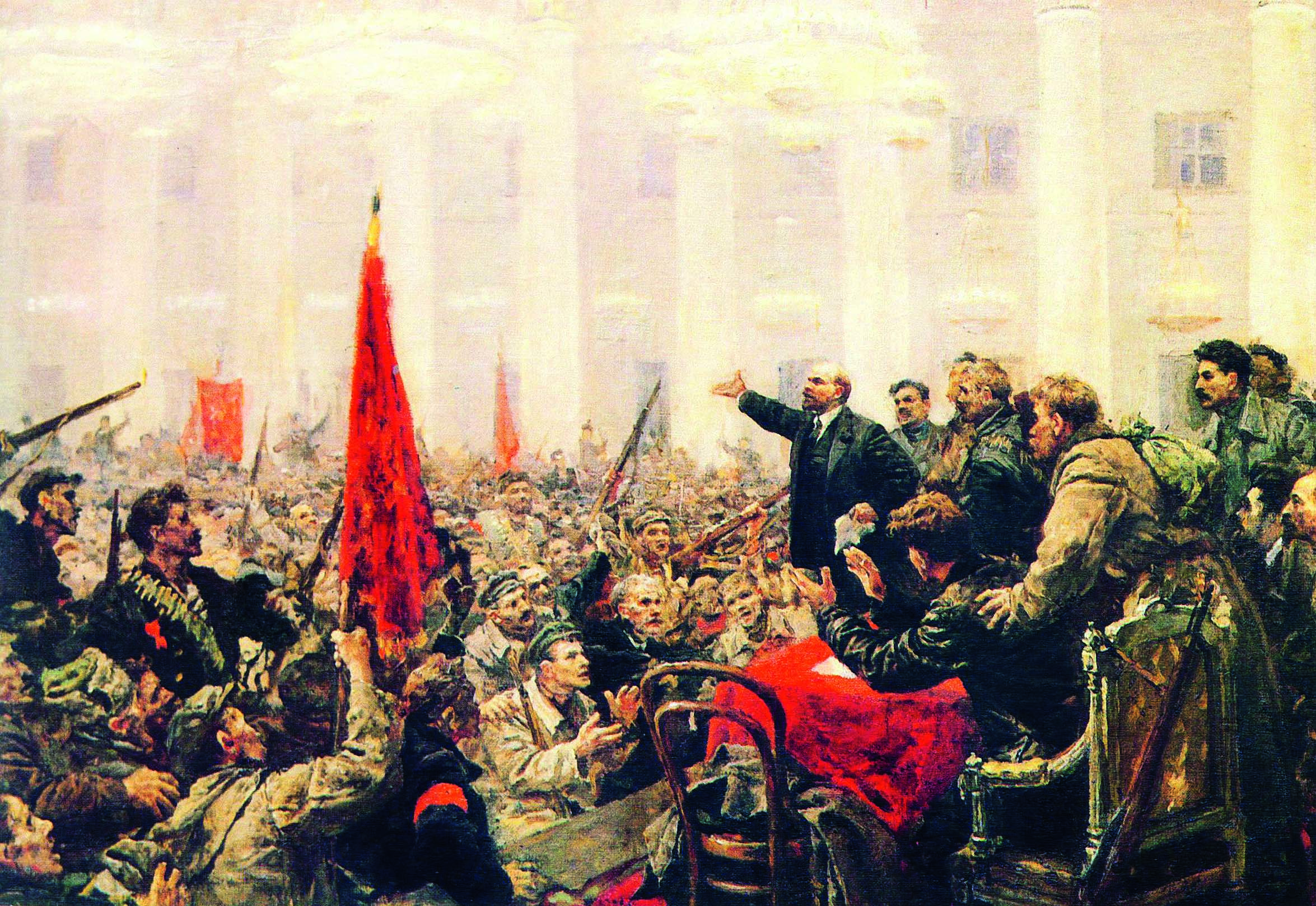More languages
More actions
| Russian Civil War | ||||||||
|---|---|---|---|---|---|---|---|---|
 | ||||||||
| ||||||||
| Belligerents | ||||||||
|
|
| Ukrainian, Polish, Finnish and other secessionists | ||||||
|
Supported by: Entente Central Powers | ||||||||
The Russian Civil War (Russian: Гражданская война в России) was a war in parts of the former Russian Empire between the Red Army and counter-revolutionary White Army. Imperialists from 14 foreign countries including the United States also intervened in the war to help the Whites. During the war, Stalin served as the President of the Southern War Front Council and Trotsky served as the People's Commissar for War. Both received the Order of the Red Banner for their military service.[1]
Background[edit | edit source]
See main article: October Revolution
On 7 November [O.S. 25 October], the Bolsheviks overthrew the Russian Republic led by Alexander Kerensky, and Kerensky fled from the Winter Palace in Petrograd to Pskov. The Menshevik Voitinsky had proposed sending troops to aid the provisional government in Petrograd but was removed in a no-confidence vote. Nikolai Kishkin from the Constitutional Democratic Party was then appointed as dictator and refrained from sending troops to Petrograd.[2]
War by region[edit | edit source]
Caucasus[edit | edit source]
Krasnov threatened to capture the North Caucasus in June 1918, but Stalin successfully defended Tsaritsyn. Stalin opposed the former Tsarist officials Sytin and Vācietis, who had been appointed by Trotsky.[1]
Anton Denikin began an offensive against the Bolsheviks in the summer of 1920 in southern Russia.[3] He was defeated, but Pyotr Wrangel advanced towards Crimea before being defeated in late 1920.[1]
Northwest Russia[edit | edit source]
In May 1919, Stalin was assigned with defending Petrograd from Nikolai Yudenich.[1]
Siberia[edit | edit source]
White General Alexander Kolchak in Omsk was declared Supreme Ruler of Russia. He advanced towards the Volga in the spring of 1919 but was defeated in April by the Red Army and retreated into Siberia.[3] The Bolsheviks captured and executed Kolchak at the end of 1919 with the help of 2,000 Bashkir soldiers who had defected from the White Army.[4]
On the eastern front, a struggle developed between the commanders Sergey Kamenev and Jukums Vācietis. The Central Committee decided in favor of Kamenev and arrested Vācietis.[1]
Many Whites fled into Mongolia and Manchuria after being defeated in Siberia, and General Ungern occupied Mongolia with the support of Japan in October 1920.[5]:283
Ukraine[edit | edit source]
In October 1918, Stalin was appointed to the Military Council of the Ukrainian Front to overthrow the German-backed ruler Pavlo Skoropadskyi.[1]
Foreign invasions[edit | edit source]
Britain and France[edit | edit source]
In the first half of 1918, British and French forces invaded northwest Russia and occupied Arkhangelsk and Murmansk, overthrew the Soviets in the area, and established the counterrevolutionary Government of North Russia. The British and French also supported White generals Kornilov, Alexeyev, and Denikin in the North Caucasus. In the Volga region and Siberia, they organized a revolt of Czechoslovak prisoners of war who had recently been released by the Soviet government.[3]
Germany[edit | edit source]
Germany invaded Ukraine in February 1918.[1] It supported Generals Krasnov and Mamontov in organizing a revolt of the Don Cossacks and occupied the Don region and Ukraine.[3]
Japan[edit | edit source]
In January 1918, Japanese forces on the cruiser Iwami invaded Vladivostok. They were followed by a British vessel, a Statesian cruiser, and another Japanese cruiser.[6] Japanese intervention in the Far East continued until 1922.[3]
Poland[edit | edit source]
See main article: Polish–Soviet War
In April 1920, Poland under the right-wing nationalist Józef Piłsudski invaded Soviet Ukraine and occupied Kiev.[3] Mikhail Tukhachevsky counterattacked, and Lenin formed a temporary Soviet Polish government as the Red Army approached Warsaw. The Polish later counterattacked and forced the Bolsheviks to retreat.[1]
United States[edit | edit source]
In December 1917, the United States authorized aid to anti-communist forces in southern Russia and the Caucasus.[7] At the end of the First World War, Woodrow Wilson sent 15,000 troops to western and eastern Russia to fight the Bolsheviks and limit the power of Japan. The USA occupied Vladivostok from August 1918 to April 1920.[8]
References[edit | edit source]
- ↑ 1.0 1.1 1.2 1.3 1.4 1.5 1.6 1.7 Ludo Martens (1996). Another View of Stalin: 'The young Stalin forges his arms' (pp. 19–20). [PDF] Editions EPO. ISBN 9782872620814
- ↑ E. Yaroslavsky, et al. (1946). The History of the Civil War in the U.S.S.R: 'The Suppression of the Anti-Soviet Mutiny'. [PDF]
- ↑ 3.0 3.1 3.2 3.3 3.4 3.5 Joseph Stalin (1939). History of the Communist Party of the Soviet Union (Bolsheviks): 'The Bolshevik Party in the Period of Foreign Military Intervention and Civil War'. [PDF] New York City: International Publishers. [MIA]
- ↑ Albert Szymanski (1984). Human Rights in the Soviet Union: 'The Asian Nationalities in the USSR' (p. 35). [PDF] London: Zed Books Ltd.. ISBN 0862320186 [LG]
- ↑ A. A. Guber, et al. (1973). History of the Mongolian People's Republic: 'The Mongolian People's Revolution and the Proclamation of the Mongolian People's Republic'.
- ↑ V. Parfenov (1941). The Intervention in Siberia (1918–1922): 'Preparation for Intervention' (p. 8). [PDF] New York City: Workers Literary Publishers, Inc..
- ↑ David S. Foglesong (1995). America's Secret War against Bolshevism: 'The British Connection' (p. 76). [PDF] University of North Carolina Press.
- ↑ David Vine (2020). The United States of War: 'The Military Opens Doors' (p. 218). Oakland: University of California Press. ISBN 9780520972070 [LG]
